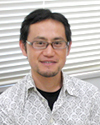
Members
A01 : Development of key techniques to investigate the minority issues in biology
To understand the protein-protein interactions based on the “number of biolmolecules”, which is the purpose of our research (the number of protein molecules in different types of cells). For this purpose, we developed a single-cell digital ELIZA to count the endogenous arbitrary proteins (Noji), obtain a comprehensive count of all protein molecules, and provide the information on a proteome map (Noji). In addition, we will develop 1) super resolution microscopy (spatial resolution of several tens nm) which can operate at video-rate (Watanabe), 2) electron spin resonance microscopy with NVC nano-diamond at video-rate (Tochio), and 3) high-speed AFM for conformational change at video-rate (Uchihashi). Not only the number of protein molecules, but also other characteristic parameters can be simultaneously and multi-dimensionally analyzed. Furthermore, we will develop indicators for the detection of such as protein phosphorylation and ion concentration by fluorescent proteins, compounds, and aptamers (Nagai, Kinbara, and Horikawa).
A01-1 :
Developing the device for quantitative molecular counting in cells to digitize limited biomolecules

- Name :
- Noji, Hiroyuki HP
- Affiliation :
- Department of Engineering, The University of Tokyo
- Major :
- Micro-device
- Role :
- Development of label-free device for counting biomolecule
Purpose
Studies on the small number issue in biology demands quantitative analytical methods to determine the absolute numbers of biomolecules in living cells or in specimens. To meet this technical requirement, we will develop novel methods with single molecule sensitivity to accurately quantify biomolecules. Particularly we will focus on the development of two strategies: single-molecule digital ELISA and in vivo single-molecule imaging methods that combines advanced super resolution microscopic techniques and novel engineered fluorescent proteins. The former allows us to quantify the number of biomolecules without genetic labeling, but it is a destructive method. On the contrary, the latter is not a destructive method, but requires a genetic labeling of the target molecules. Thus, the two methods are complimentary, and will enable us to respond to the technical demands of the other groups working on this project.
| Name | Affiliation | Major | Role | |
|---|---|---|---|---|
| Co-Investigators (kenkyu-buntansha) | ||||
 |
Watanabe, M., Tomonobu HP |
RIKEN QBiC | Biophysical engineering | Development of high-speed superresolution fluorescence microscopy |
 |
Ichimura, Taro HP |
RIKEN QBiC | Nonlinear optics | Research on the principle of non-linear optical base system |
| Co-Investigator (renkei kenkyusha) | ||||
 |
Fujita, Katsumasa HP |
Department of Applied Physics, Osaka University | Nonlinear optics | Support to construct an optical system |
A01-2 :
Development of molecular probes and light-driven tools for imaging and manipulation of biomolecules in minority

- Name :
- Nagai, TakeharuHP
- Affiliation :
- The Institute of Scientific and Industrial Research, Osaka University
- Major :
- Engineering of molecular biology
- Role :
- Development and design of functional proteins
Purpose
The primary goal of our study is to elucidate how a biomolecular network system is orchestrated by a small number of elements that work in a robust manner. We believe that we cannot approach such issues using conventional phenotypic analyses of the living specimen that are exposed to an extreme condition due to overdose drug treatments as well as overexpression or depletion of genes/proteins of interest. Rather, we should examine the effect of physiologically relevant perturbations on the living specimen that are under a particular physiological condition, and then analyze the samples at a high spatio-temporal resolution. In this research, we would like to understand the principle behind the cooperativity (or coherency) among small number of molecules/cells by developing technologies that will help to visualize, count, and control the biomolecules participating in spontaneous physiological phenomena. Subsequently, these technologies can be used to figure out the robustness of chemo-taxis and photo-taxis induced by extremely weak signals.
| Name | Affiliation | Major | Role | |
|---|---|---|---|---|
| Co-Investigators (kenkyu-buntansha) | ||||
 |
Kinbara, Kazushi HP | School and Graduate School of Bioscience and Biotechnology, Tokyo Institute of Technology | Synthetic organic chemistry | Development of functional organic chemical compounds |
 |
Horikawa, Kazuki | Institute of Biomedical Sciences, Tokushima University | Developmental biology | Construction and analysis of the functional probe |
| Co-Investigators (renkei kenkyusha) | ||||
 |
Sando, Shinsuke | Graduate school of engineering, The University of Tokyo | Chemical biology | Support for the synthesis of functional chemical compounds |
 |
Urano, Yasuteru HP |
Graduate school of Medicine and Faculty of Medicine, The University of Tokyo | Organic chemistry | Support for the synthesis of functional organic chemical compounds |
 |
Ozawa, Takeaki HP |
Graduate school of science, The University of Tokyo | Analytical chemistry | Support for manipulation and analysis of biomolecules |
 |
Matsuda, Tomoki HP |
The Institute of Scientific and Industrial Research, Osaka University | Protein engineering | Support for the development of functional fluorescence probes |
 |
Arai, Yoshiyuki HP |
The Institute of Scientific and Industrial Research, Osaka University | Biophysics | Support for the construction of optical microscopy |